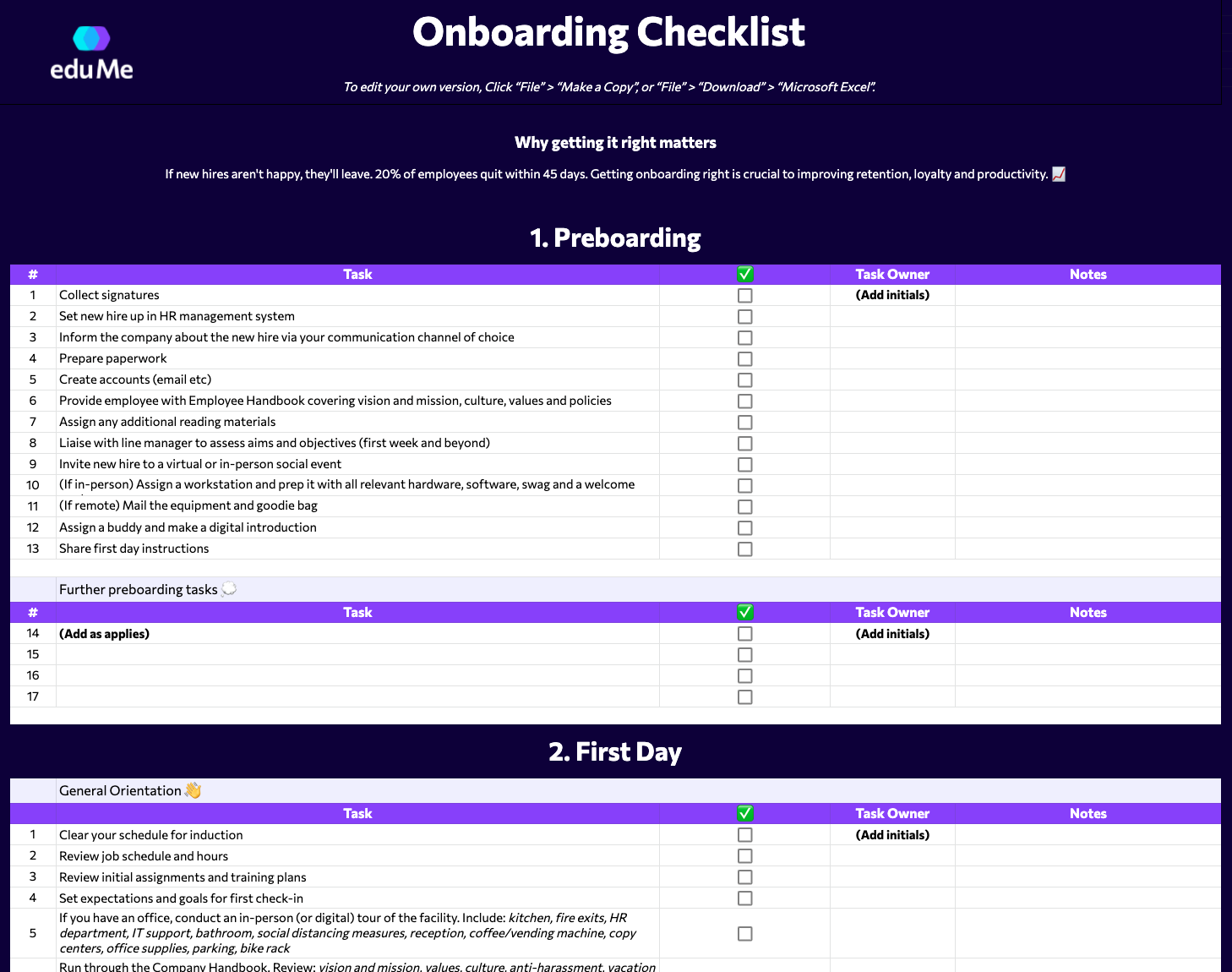Onboarding Checklist Template
Get your new hires off to the best start with this easy to use checklist.

Quick Navigation
- How do you define an employee onboarding program?
- What is an employee onboarding checklist?
- What is the value of an onboarding checklist template?
- The 4 phases of onboarding
- What should I include in my employee onboarding checklist?
- The 4 Cs of onboarding
- How an onboarding process checklist benefits HR teams
How do you define an employee onboarding program?
Onboarding is the process of integrating an employee into an organization and is a time-critical stage where new starters need to learn and gain the necessary skills and knowledge to be successful in their role.
Employee retention and productivity are fundamental to successful onboarding outcomes which makes an onboarding checklist template valuable for organizations and new starters.
Organizations without established induction programs noted lower employee productivity and engagement with 50% of employees leaving within the first 120 days, and even if turnover isn’t the outcome, organizations that underinvest in their onboarding process risk low engagement, employee dissatisfaction, and poor performance. In contrast, a poor onboarding process can lead to high levels of employee dissatisfaction, low engagement, poor performance and in a worst-case scenario - turnover.
What is an employee onboarding checklist?
An employee onboarding checklist is a guided document detailing the critical steps to integrate a new employee by coordinating relevant information and resources to welcome new starters in their role. Organizations that successfully engage new employees through their onboarding programs see employees 69% more likely to stay for three years.
For organizations and HR leaders, clearly defining this process puts organizations in a better position to meet their new starters’ needs. It helps them get started on the best foot possible, and in a way that promotes high engagement and primes the path for longer-term employee retention.
In contrast, a poor onboarding process can lead to high levels of employee dissatisfaction, low engagement, poor performance and in a worst-case scenario - turnover.
What is the value of an onboarding checklist template?
The value of an onboarding checklist template works on two levels. Organizations ensure they don’t miss out on any crucial steps when integrating a new employee during their onboarding process by removing any uncertainty in relation to a new hire’s role, team, and company by e.g. clarifying their job responsibilities, where they sit in a team, and your company’s values.
For new starters, the value of an onboarding checklist template is that they understand what’s expected of them within their first days, weeks, and months of employment, and as a result, can become productive, happier, more successful members of the team and the organization earlier on.
Because employees are better equipped to succeed, a defined onboarding process can improve new hire retention by 82% and productivity by 70%.
An onboarding checklist is also a document for new employees and their organizations to refer back to. It’s a valuable centralized source of information that both employees and hiring managers can look at, use to track progress, and stay informed of what the next steps might be, to avoid ambiguity or confusion on either side and promote visibility and transparency
As onboarding even a single employee involves multiple stakeholder input, an onboarding template supplies organizations and HR departments with a step-by-step guide that aligns relevant internal teams, consolidates knowledge, and acts as a resource that formalizes a company’s onboarding workflow, enabling improvements to be made in an iterative and ongoing way, in line with an organization’s needs.
The 4 phases of onboarding
From company policies to setting up payroll accounts, creating an employee onboarding checklist involves interacting, motivating, and maximizing productivity from their first day through 4 phases:
- Preboarding: Preparing new starters with equipment, setting up employee accounts, and introducing the company through handbooks.
- First day: Involves a digital orientation (informs a new starter on what technologies are used) and aclimatizing to the company culture with team introductions (how teams are structured and operate on a daily basis).
- First week: Role-focused, where individual goals are set for new starters and feedback is given and/or received through periodic check-ins.
- First month: The last phase of onboarding is about a new starter’s ongoing development focusing on their progress through 30, 60, or 90-day check-ins and continued training.
What should I include in my employee onboarding checklist?
The basis of any employee onboarding checklist should take the 5 Cs of onboarding into consideration. These include ‘Compliance’, ‘Clarification’, ‘Confidence’, and ‘Connection’.
The 4 Cs of onboarding
Compliance refers to an employee operating and adhering to their jobs and responsibilities within the legal framework of the organization they work in. While onboarding an employee, it’s about ensuring a new starter is aware of and understands standard workplace compliance training (e.g.) including Workplace Safety (OSHA) and Information Security Training (HIPPA).
Clarification is about the degree to which an employee understands their performance expectations that fall within the scope of their job-related duties and responsibilities. During onboarding, clarification is about eliminating any ambiguity as to what an employee needs to be doing, how they do it, and how the organization functions within the company parameters in terms of rules and protocols.
Culture is about introducing new employees to the norms and values of an organization and how they fit within their goals and objectives. One way to do this is through a company handbook, where new starters can get an insight into the history of the company and how it started, and how the organizational values impact the way how it operates in its day-to-day.
Connection is associated with developing a sense of connection to the workplace. When onboarding new starters, beyond addressing any questions they may have regarding their role or the overall organization, it’s equally valuable to introduce them to other departments to promote a sense of trust not only to the organization but also to the people they work with. Even a simple welcome video from senior management can go a long way in fostering a sense of emotional connection and commitment to the workplace.
How an onboarding process checklist benefits HR teams
For HR leaders, onboarding is not a one-size fits all process. Depending on the industry, company size, requirements, and other external factors in your macro environment (e.g. legislation), onboarding is an ongoing process that needs constant refining and tailoring to suit each company’s individual requirements.
Onboarding waitstaff, for instance, will differ from the onboarding a corporate employee might need. For instance, for hospitality teams, induction will most likely revolve around soft skills like customer service (e.g. conflict resolution training), as well as occupational health and safety training (e.g. including operating technical machinery, lifting heavy items, and food hygiene training).
While onboarding for an office worker will likely revolve around training on internal processes (e.g. guidelines for setting an out-of-office email), ensuring wellbeing in a desk-based context (e.g. ergonomics in the workplace), or quality training (e.g. product compliance with industry standards).
On this basis, organizations and HR teams need to be pragmatic in their approach when onboarding new starters and refine it based on their individual needs, using a well-defined structure as a foundation for further customization to be made as and when needed, that can be accessed by and referred to by all involved parties on an ongoing basis.
Though the best onboarding process is a personalized onboarding process, our onboarding checklist template equips you with the framework necessary to execute a 360 onboarding plan, whatever your industry.



